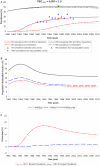Genital herpes has played a more important role than any other sexually transmitted infection in driving HIV prevalence in Africa
- PMID: 18493617
- PMCID: PMC2377333
- DOI: 10.1371/journal.pone.0002230
Genital herpes has played a more important role than any other sexually transmitted infection in driving HIV prevalence in Africa
Abstract
Background: Extensive evidence from observational studies suggests a role for genital herpes in the HIV epidemic. A number of herpes vaccines are under development and several trials of the efficacy of HSV-2 treatment with acyclovir in reducing HIV acquisition, transmission, and disease progression have just reported their results or will report their results in the next year. The potential impact of these interventions requires a quantitative assessment of the magnitude of the synergy between HIV and HSV-2 at the population level.
Methods and findings: A deterministic compartmental model of HIV and HSV-2 dynamics and interactions was constructed. The nature of the epidemiologic synergy was explored qualitatively and quantitatively and compared to other sexually transmitted infections (STIs). The results suggest a more substantial role for HSV-2 in fueling HIV spread in sub-Saharan Africa than other STIs. We estimate that in settings of high HSV-2 prevalence, such as Kisumu, Kenya, more than a quarter of incident HIV infections may have been attributed directly to HSV-2. HSV-2 has also contributed considerably to the onward transmission of HIV by increasing the pool of HIV positive persons in the population and may explain one-third of the differential HIV prevalence among the cities of the Four City study. Conversely, we estimate that HIV had only a small net impact on HSV-2 prevalence.
Conclusions: HSV-2 role as a biological cofactor in HIV acquisition and transmission may have contributed substantially to HIV particularly by facilitating HIV spread among the low-risk population with stable long-term sexual partnerships. This finding suggests that prevention of HSV-2 infection through a prophylactic vaccine may be an effective intervention both in nascent epidemics with high HIV incidence in the high risk groups, and in established epidemics where a large portion of HIV transmission occurs in stable partnerships.
Conflict of interest statement
Figures






References
-
- UNAIDS/WHO AIDS epidemic update 2005 (available at http://www.unaids.org/epi/2005/doc/report_pdf.asp, accessed 11 April 2006)
-
- Smith JS, Robinson NJ. Age-specific prevalence of infection with herpes simplex virus types 2 and 1: a global review. J Infect Dis. 2002;186(Suppl 1):S3–28. - PubMed
-
- Weiss H. Epidemiology of herpes simplex virus type 2 infection in the developing world. Herpes. 2004;11(Suppl 1):24A–35A. - PubMed
-
- Korenromp EL, Bakker R, De Vlas SJ, Robinson NJ, Hayes R, et al. Can behavior change explain increases in the proportion of genital ulcers attributable to herpes in sub-Saharan Africa? A simulation modeling study. Sex Transm Dis. 2002;29:228–238. - PubMed
Publication types
MeSH terms
Grants and funding
LinkOut - more resources
Full Text Sources
Other Literature Sources
Medical

